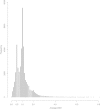From prescriptions to drug use periods - things to notice
- PMID: 25398553
- PMCID: PMC4239374
- DOI: 10.1186/1756-0500-7-796
From prescriptions to drug use periods - things to notice
Abstract
Background: Electronic prescription registers provide a vast data source for pharmacoepidemiological research. Prescriptions as such are not suitable for all research purposes; e.g., studying concurrent use of different drugs or adverse drug events during current use. For those purposes, data on dispensed prescriptions needs to be transformed to periods of drug use.
Methods: We used 3,828,292 dispensed prescriptions claimed between 1 January 2002 and 31 December 2009 for 28,093 persons with Alzheimer's disease. Examples of drug use histories are presented to discuss different aspects that should be noticed when using register-based data consisting of drug purchases.
Results: There is no simple method for correctly transforming dispensed prescriptions to periods of drug use that is usable for all drugs and drug users. Fixed assumptions of daily dose (in defined daily doses, tablets or other units) and fixed time windows should be used with caution and adjusted for different drug use patterns.
Conclusions: We recommend that when transforming prescription drug purchases to drug use periods personal dose, purchasing pattern and other behavioral differences between patients should be taken into account.
Figures







References
-
- Andersen UA, Andersen M, Rosholm JU, Gram LF. Contacts to the health care system prior to suicide: a comprehensive analysis using registers for general and psychiatric hospital admissions, contacts to general practitioners and practising specialists and drug prescriptions. Acta Psychiatr Scand. 2000;102:126–134. doi: 10.1034/j.1600-0447.2000.102002126.x. - DOI - PubMed
Publication types
MeSH terms
Substances
LinkOut - more resources
Full Text Sources
Other Literature Sources
Medical

